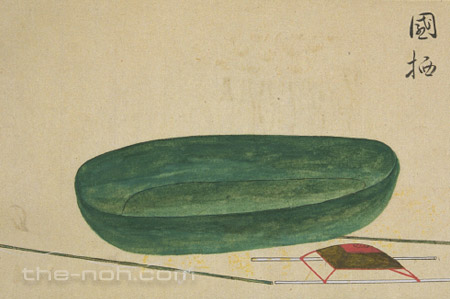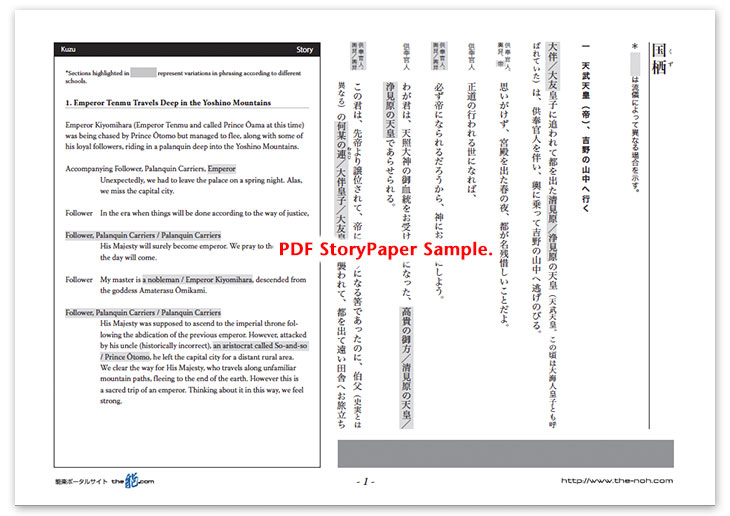
 Kuzu
Kuzu

![]()
Having been attacked by a member of his extended family (Prince Ōtomo), a nobleman (Emperor Kiyomihara) (Emperor Tenmu), together with some of his loyal followers, has escaped to the mountainous area in Yoshino, where he is resting in a cottage by a river. Then, the homeowners, an old couple, return to the house by boat. Observing a miraculous omen above their shabby cottage, the couple wonders if some noble person might be in their house.
When they enter their cottage, just as they supposed, the emperor is resting there. After listening to his story of what happened to him, the couple offers him their home as a hiding place. One of the loyal followers who is accompanying His Majesty asks the couple to offer a meal to the emperor. As requested, they prepare freshly picked cicely and cook a kuzu fish (sweetfish) for His Majesty. The emperor eats only one side of the fish, giving the rest to the old man. Since the fish looks as if it is still alive, the old man releases the leftover fish into the river. Then the fish comes back to life. The old man interprets this as an auspicious sign portending that His Majesty will return to the capital city and gives the emperor encouragement.
Now the emperor’s pursuers come to the house. The old man, thinking fast, hides the emperor behind his fishing boat, which is flipped over. When the emperor’s pursuers question the old man, he pretends to know nothing and brushes off their questions. However, the pursuers become suspicious about the boat and insist upon investigating it. The old man acts as if he were furious. He refuses their request and calls out to his relatives who live in the neighborhood. Intimidated by his spirited defense, the pursuers run away. Saved by the couple, the emperor bestows words of appreciation on them that move them to tears.
When the night grows late, the old couple disappears and in their place, a celestial maiden appears. When she dances, the god Zaō-gongen, enticed by the music of dance, makes his appearance. He manifests his brilliant dignity in celebration of the coming reign of the emperor.
![]()
This story is based on an ancient incident that occurred during the Jinshin Rebellion (672 CE). The title of this piece, Kuzu (国栖), is the name of the aboriginal tribe of the Yoshino region, as well as the name of the region where this tribe lived. (Kuzu is also written as 国樔 or 国巣 in Chinese characters).
Among a number of dynamic scenes and highlights in this drama, we would like to introduce a few that are especially outstanding and impressive. First, there is a scene in which the emperor eats one side of a roasted sweetfish. When the old man releases the uneaten half of the fish into the river, the fish comes back to life. The old man gives everyone encouragement by saying that it is a good omen. This scene, known as “Ayu-no-dan (The Scene of Sweetfish),”is one of the most remarkable Noh scenes to see and to hear performed. There is also the scene in which the old man quickly hides the emperor behind his boat and chases off his pursuers. The old man’s spirit stands out in this tense atmosphere, becoming the climax of the first half of the drama. In this scene, a kokata (child player) performs an important role by hiding in a dark boat, appealing to the audience with his earnest performance. One of the highlights in the second half of the drama is the scene tsure performs an elegant Tennyo-no-mai (dance of celestial maiden). This dance is known as unique to Kuzu. Another highlight is the powerful, dashing dance performed by shite, the god Zaō-gongen, at the play’s conclusion. These scenes make this play profoundly vivid and attractive.
Every scene of this play is infused with the atmosphere of the simple, rustic scenery of olden times, recreating it before our very eyes so that we can thoroughly enjoy being immersed in that ancient world.
STORY PAPER : Kuzu
Story Paper presents noh chant stories in modern speech, with story outlines, highlights and more using Adobe PDF format, which can print out and zoom in. Print out the pages and take them with you when you see the actual noh performance.

The copyright of Story Paper is held by the Noh.com. Story Paper is for individual use only. It is prohibited by the copyright law to distribute or publish printed-out Story Paper pages without prior consent. For more information, check the credit and disclaimer pages.



 [Kuzu : Story Paper PDF : 555KB
[Kuzu : Story Paper PDF : 555KB